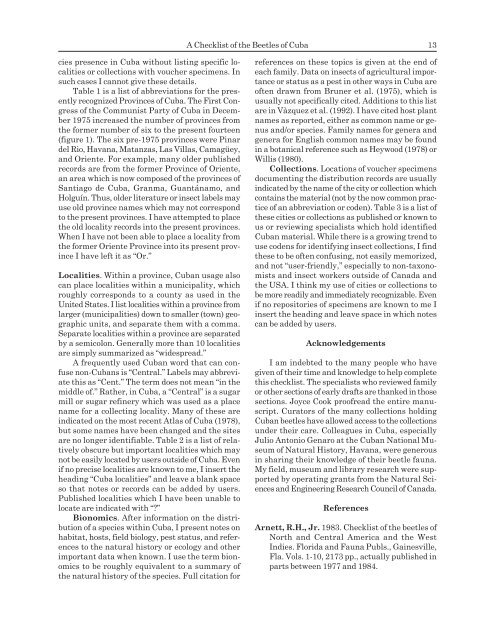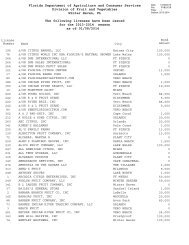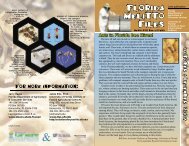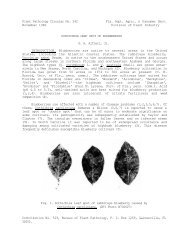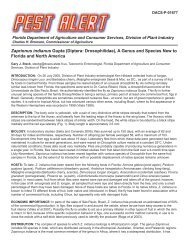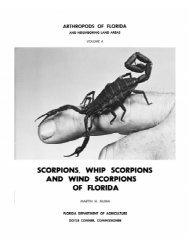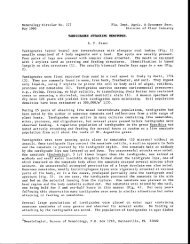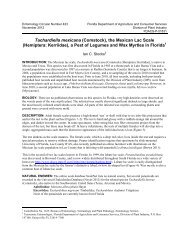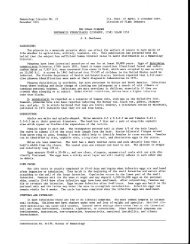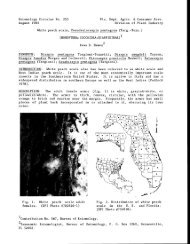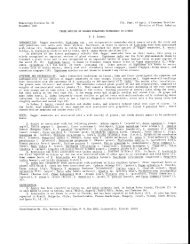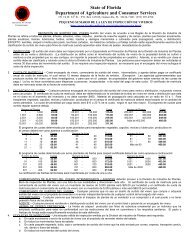A Checklist of the Beetles of Cuba with Data on Distributions and ...
A Checklist of the Beetles of Cuba with Data on Distributions and ...
A Checklist of the Beetles of Cuba with Data on Distributions and ...
You also want an ePaper? Increase the reach of your titles
YUMPU automatically turns print PDFs into web optimized ePapers that Google loves.
cies presence in <str<strong>on</strong>g>Cuba</str<strong>on</strong>g> <str<strong>on</strong>g>with</str<strong>on</strong>g>out listing specific localities<br />
or collecti<strong>on</strong>s <str<strong>on</strong>g>with</str<strong>on</strong>g> voucher specimens. In<br />
such cases I cannot give <str<strong>on</strong>g>the</str<strong>on</strong>g>se details.<br />
Table 1 is a list <str<strong>on</strong>g>of</str<strong>on</strong>g> abbreviati<strong>on</strong>s for <str<strong>on</strong>g>the</str<strong>on</strong>g> presently<br />
recognized Provinces <str<strong>on</strong>g>of</str<strong>on</strong>g> <str<strong>on</strong>g>Cuba</str<strong>on</strong>g>. The First C<strong>on</strong>gress<br />
<str<strong>on</strong>g>of</str<strong>on</strong>g> <str<strong>on</strong>g>the</str<strong>on</strong>g> Communist Party <str<strong>on</strong>g>of</str<strong>on</strong>g> <str<strong>on</strong>g>Cuba</str<strong>on</strong>g> in December<br />
1975 increased <str<strong>on</strong>g>the</str<strong>on</strong>g> number <str<strong>on</strong>g>of</str<strong>on</strong>g> provinces from<br />
<str<strong>on</strong>g>the</str<strong>on</strong>g> former number <str<strong>on</strong>g>of</str<strong>on</strong>g> six to <str<strong>on</strong>g>the</str<strong>on</strong>g> present fourteen<br />
(figure 1). The six pre-1975 provinces were Pinar<br />
del Rio, Havana, Matanzas, Las Villas, Camagüey,<br />
<strong>and</strong> Oriente. For example, many older published<br />
records are from <str<strong>on</strong>g>the</str<strong>on</strong>g> former Province <str<strong>on</strong>g>of</str<strong>on</strong>g> Oriente,<br />
an area which is now composed <str<strong>on</strong>g>of</str<strong>on</strong>g> <str<strong>on</strong>g>the</str<strong>on</strong>g> provinces <str<strong>on</strong>g>of</str<strong>on</strong>g><br />
Santiago de <str<strong>on</strong>g>Cuba</str<strong>on</strong>g>, Granma, Guantánamo, <strong>and</strong><br />
Holguín. Thus, older literature or insect labels may<br />
use old province names which may not corresp<strong>on</strong>d<br />
to <str<strong>on</strong>g>the</str<strong>on</strong>g> present provinces. I have attempted to place<br />
<str<strong>on</strong>g>the</str<strong>on</strong>g> old locality records into <str<strong>on</strong>g>the</str<strong>on</strong>g> present provinces.<br />
When I have not been able to place a locality from<br />
<str<strong>on</strong>g>the</str<strong>on</strong>g> former Oriente Province into its present province<br />
I have left it as “Or.”<br />
Localities. Within a province, <str<strong>on</strong>g>Cuba</str<strong>on</strong>g>n usage also<br />
can place localities <str<strong>on</strong>g>with</str<strong>on</strong>g>in a municipality, which<br />
roughly corresp<strong>on</strong>ds to a county as used in <str<strong>on</strong>g>the</str<strong>on</strong>g><br />
United States. I list localities <str<strong>on</strong>g>with</str<strong>on</strong>g>in a province from<br />
larger (municipalities) down to smaller (town) geographic<br />
units, <strong>and</strong> separate <str<strong>on</strong>g>the</str<strong>on</strong>g>m <str<strong>on</strong>g>with</str<strong>on</strong>g> a comma.<br />
Separate localities <str<strong>on</strong>g>with</str<strong>on</strong>g>in a province are separated<br />
by a semicol<strong>on</strong>. Generally more than 10 localities<br />
are simply summarized as “widespread.”<br />
A frequently used <str<strong>on</strong>g>Cuba</str<strong>on</strong>g>n word that can c<strong>on</strong>fuse<br />
n<strong>on</strong>-<str<strong>on</strong>g>Cuba</str<strong>on</strong>g>ns is “Central.” Labels may abbreviate<br />
this as “Cent.” The term does not mean “in <str<strong>on</strong>g>the</str<strong>on</strong>g><br />
middle <str<strong>on</strong>g>of</str<strong>on</strong>g>.” Ra<str<strong>on</strong>g>the</str<strong>on</strong>g>r, in <str<strong>on</strong>g>Cuba</str<strong>on</strong>g>, a “Central” is a sugar<br />
mill or sugar refinery which was used as a place<br />
name for a collecting locality. Many <str<strong>on</strong>g>of</str<strong>on</strong>g> <str<strong>on</strong>g>the</str<strong>on</strong>g>se are<br />
indicated <strong>on</strong> <str<strong>on</strong>g>the</str<strong>on</strong>g> most recent Atlas <str<strong>on</strong>g>of</str<strong>on</strong>g> <str<strong>on</strong>g>Cuba</str<strong>on</strong>g> (1978),<br />
but some names have been changed <strong>and</strong> <str<strong>on</strong>g>the</str<strong>on</strong>g> sites<br />
are no l<strong>on</strong>ger identifiable. Table 2 is a list <str<strong>on</strong>g>of</str<strong>on</strong>g> relatively<br />
obscure but important localities which may<br />
not be easily located by users outside <str<strong>on</strong>g>of</str<strong>on</strong>g> <str<strong>on</strong>g>Cuba</str<strong>on</strong>g>. Even<br />
if no precise localities are known to me, I insert <str<strong>on</strong>g>the</str<strong>on</strong>g><br />
heading “<str<strong>on</strong>g>Cuba</str<strong>on</strong>g> localities” <strong>and</strong> leave a blank space<br />
so that notes or records can be added by users.<br />
Published localities which I have been unable to<br />
locate are indicated <str<strong>on</strong>g>with</str<strong>on</strong>g> “?”<br />
Bi<strong>on</strong>omics. After informati<strong>on</strong> <strong>on</strong> <str<strong>on</strong>g>the</str<strong>on</strong>g> distributi<strong>on</strong><br />
<str<strong>on</strong>g>of</str<strong>on</strong>g> a species <str<strong>on</strong>g>with</str<strong>on</strong>g>in <str<strong>on</strong>g>Cuba</str<strong>on</strong>g>, I present notes <strong>on</strong><br />
habitat, hosts, field biology, pest status, <strong>and</strong> references<br />
to <str<strong>on</strong>g>the</str<strong>on</strong>g> natural history or ecology <strong>and</strong> o<str<strong>on</strong>g>the</str<strong>on</strong>g>r<br />
important data when known. I use <str<strong>on</strong>g>the</str<strong>on</strong>g> term bi<strong>on</strong>omics<br />
to be roughly equivalent to a summary <str<strong>on</strong>g>of</str<strong>on</strong>g><br />
<str<strong>on</strong>g>the</str<strong>on</strong>g> natural history <str<strong>on</strong>g>of</str<strong>on</strong>g> <str<strong>on</strong>g>the</str<strong>on</strong>g> species. Full citati<strong>on</strong> for<br />
A <str<strong>on</strong>g>Checklist</str<strong>on</strong>g> <str<strong>on</strong>g>of</str<strong>on</strong>g> <str<strong>on</strong>g>the</str<strong>on</strong>g> <str<strong>on</strong>g>Beetles</str<strong>on</strong>g> <str<strong>on</strong>g>of</str<strong>on</strong>g> <str<strong>on</strong>g>Cuba</str<strong>on</strong>g> 13<br />
references <strong>on</strong> <str<strong>on</strong>g>the</str<strong>on</strong>g>se topics is given at <str<strong>on</strong>g>the</str<strong>on</strong>g> end <str<strong>on</strong>g>of</str<strong>on</strong>g><br />
each family. <str<strong>on</strong>g>Data</str<strong>on</strong>g> <strong>on</strong> insects <str<strong>on</strong>g>of</str<strong>on</strong>g> agricultural importance<br />
or status as a pest in o<str<strong>on</strong>g>the</str<strong>on</strong>g>r ways in <str<strong>on</strong>g>Cuba</str<strong>on</strong>g> are<br />
<str<strong>on</strong>g>of</str<strong>on</strong>g>ten drawn from Bruner et al. (1975), which is<br />
usually not specifically cited. Additi<strong>on</strong>s to this list<br />
are in Vàzquez et al. (1992). I have cited host plant<br />
names as reported, ei<str<strong>on</strong>g>the</str<strong>on</strong>g>r as comm<strong>on</strong> name or genus<br />
<strong>and</strong>/or species. Family names for genera <strong>and</strong><br />
genera for English comm<strong>on</strong> names may be found<br />
in a botanical reference such as Heywood (1978) or<br />
Willis (1980).<br />
Collecti<strong>on</strong>s. Locati<strong>on</strong>s <str<strong>on</strong>g>of</str<strong>on</strong>g> voucher specimens<br />
documenting <str<strong>on</strong>g>the</str<strong>on</strong>g> distributi<strong>on</strong> records are usually<br />
indicated by <str<strong>on</strong>g>the</str<strong>on</strong>g> name <str<strong>on</strong>g>of</str<strong>on</strong>g> <str<strong>on</strong>g>the</str<strong>on</strong>g> city or collecti<strong>on</strong> which<br />
c<strong>on</strong>tains <str<strong>on</strong>g>the</str<strong>on</strong>g> material (not by <str<strong>on</strong>g>the</str<strong>on</strong>g> now comm<strong>on</strong> practice<br />
<str<strong>on</strong>g>of</str<strong>on</strong>g> an abbreviati<strong>on</strong> or coden). Table 3 is a list <str<strong>on</strong>g>of</str<strong>on</strong>g><br />
<str<strong>on</strong>g>the</str<strong>on</strong>g>se cities or collecti<strong>on</strong>s as published or known to<br />
us or reviewing specialists which hold identified<br />
<str<strong>on</strong>g>Cuba</str<strong>on</strong>g>n material. While <str<strong>on</strong>g>the</str<strong>on</strong>g>re is a growing trend to<br />
use codens for identifying insect collecti<strong>on</strong>s, I find<br />
<str<strong>on</strong>g>the</str<strong>on</strong>g>se to be <str<strong>on</strong>g>of</str<strong>on</strong>g>ten c<strong>on</strong>fusing, not easily memorized,<br />
<strong>and</strong> not “user-friendly,” especially to n<strong>on</strong>-tax<strong>on</strong>omists<br />
<strong>and</strong> insect workers outside <str<strong>on</strong>g>of</str<strong>on</strong>g> Canada <strong>and</strong><br />
<str<strong>on</strong>g>the</str<strong>on</strong>g> USA. I think my use <str<strong>on</strong>g>of</str<strong>on</strong>g> cities or collecti<strong>on</strong>s to<br />
be more readily <strong>and</strong> immediately recognizable. Even<br />
if no repositories <str<strong>on</strong>g>of</str<strong>on</strong>g> specimens are known to me I<br />
insert <str<strong>on</strong>g>the</str<strong>on</strong>g> heading <strong>and</strong> leave space in which notes<br />
can be added by users.<br />
Acknowledgements<br />
I am indebted to <str<strong>on</strong>g>the</str<strong>on</strong>g> many people who have<br />
given <str<strong>on</strong>g>of</str<strong>on</strong>g> <str<strong>on</strong>g>the</str<strong>on</strong>g>ir time <strong>and</strong> knowledge to help complete<br />
this checklist. The specialists who reviewed family<br />
or o<str<strong>on</strong>g>the</str<strong>on</strong>g>r secti<strong>on</strong>s <str<strong>on</strong>g>of</str<strong>on</strong>g> early drafts are thanked in those<br />
secti<strong>on</strong>s. Joyce Cook pro<str<strong>on</strong>g>of</str<strong>on</strong>g>read <str<strong>on</strong>g>the</str<strong>on</strong>g> entire manuscript.<br />
Curators <str<strong>on</strong>g>of</str<strong>on</strong>g> <str<strong>on</strong>g>the</str<strong>on</strong>g> many collecti<strong>on</strong>s holding<br />
<str<strong>on</strong>g>Cuba</str<strong>on</strong>g>n beetles have allowed access to <str<strong>on</strong>g>the</str<strong>on</strong>g> collecti<strong>on</strong>s<br />
under <str<strong>on</strong>g>the</str<strong>on</strong>g>ir care. Colleagues in <str<strong>on</strong>g>Cuba</str<strong>on</strong>g>, especially<br />
Julio Ant<strong>on</strong>io Genaro at <str<strong>on</strong>g>the</str<strong>on</strong>g> <str<strong>on</strong>g>Cuba</str<strong>on</strong>g>n Nati<strong>on</strong>al Museum<br />
<str<strong>on</strong>g>of</str<strong>on</strong>g> Natural History, Havana, were generous<br />
in sharing <str<strong>on</strong>g>the</str<strong>on</strong>g>ir knowledge <str<strong>on</strong>g>of</str<strong>on</strong>g> <str<strong>on</strong>g>the</str<strong>on</strong>g>ir beetle fauna.<br />
My field, museum <strong>and</strong> library research were supported<br />
by operating grants from <str<strong>on</strong>g>the</str<strong>on</strong>g> Natural Sciences<br />
<strong>and</strong> Engineering Research Council <str<strong>on</strong>g>of</str<strong>on</strong>g> Canada.<br />
References<br />
Arnett, R.H., Jr. 1983. <str<strong>on</strong>g>Checklist</str<strong>on</strong>g> <str<strong>on</strong>g>of</str<strong>on</strong>g> <str<strong>on</strong>g>the</str<strong>on</strong>g> beetles <str<strong>on</strong>g>of</str<strong>on</strong>g><br />
North <strong>and</strong> Central America <strong>and</strong> <str<strong>on</strong>g>the</str<strong>on</strong>g> West<br />
Indies. Florida <strong>and</strong> Fauna Publs., Gainesville,<br />
Fla. Vols. 1-10, 2173 pp., actually published in<br />
parts between 1977 <strong>and</strong> 1984.


